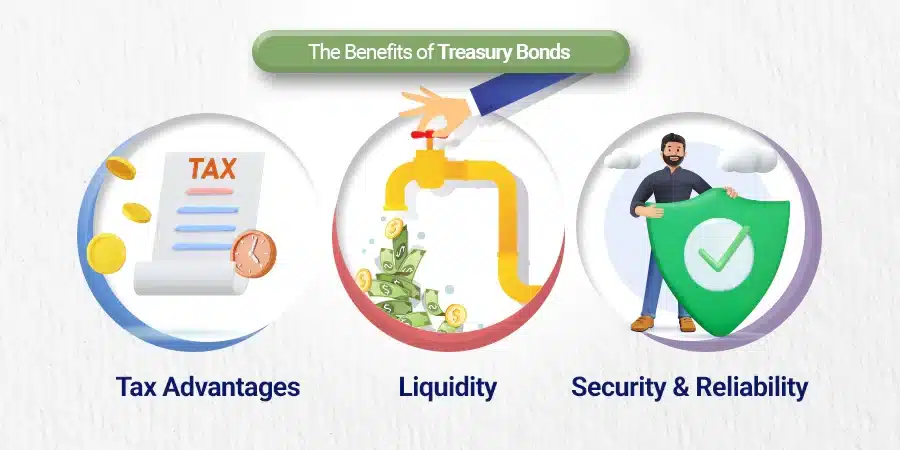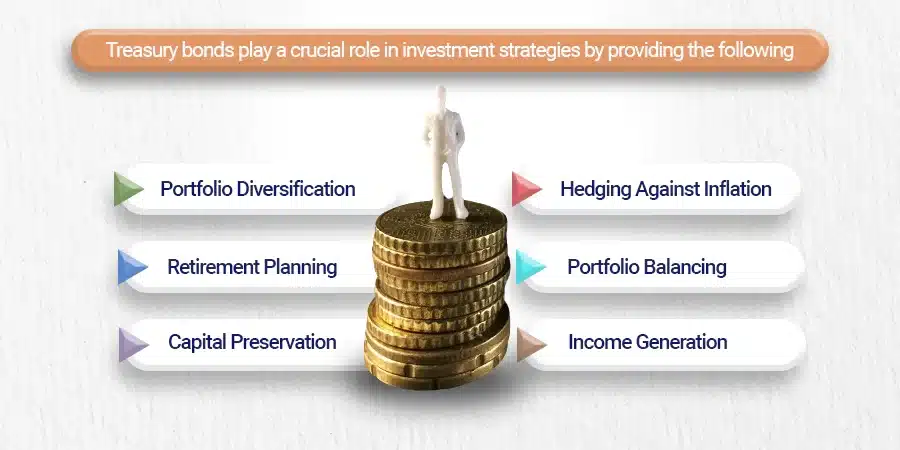Are you striving to make sense of the investment world? If so, understanding Treasury bonds – a low-risk and stable opportunity – can be an excellent place to start.
This article will guide you through the maze that is Treasury Bonds, elucidating their benefits, inherent risks, and how they fit into your overall financial strategy.
Let’s delve to decode this important piece of your financial puzzle!
Key takeaways
●Treasury bonds are low-risk investments issued by the U.S. government that provide a steady stream of income through interest payments.
●They offer tax advantages, liquidity, and security for investors.
●Potential risks include interest rate risk, inflation risk, and reinvestment risk.
●Investors can buy the treasury bond through auctions or brokers and they play a crucial role in portfolio diversification and retirement planning.
Understanding Treasury Bonds
Treasury Bonds (t-bonds) are fixed-income securities issued by the U.S. government and are considered low-risk investments that provide a steady stream of income through interest payments compared to Treasury notes and Treasury bills.

Definition and Importance
Treasury bonds are low-risk securities. The treasury bonds are part of the U.S. federal government.
They have a set return and offer safety to your money. These bonds don’t face state or local income taxes but are subject to federal income taxes, offering tax perks too! Plus, the sale of these funds helps the government pay for its tasks and pay back debt.
Their importance lies in their role as stable ways to grow cash over long periods, like 20 or 30 years. In this way, treasury bonds bring peace of mind while making sure you earn from your hard-earned dollars.
Various Types of Treasury Securities
Let’s jump into the types of Treasury securities. First, we have Treasury bonds. These are long-term loans to the U.S. government. They last 20 or 30 years.
Although the term “Treasury bonds” is frequently used to refer to all types of government bonds, Treasury bonds are only one type of Treasury security. Treasury bills and Treasury notes are the other two most popular.
The only difference between these types of Treasury securities is the time until maturity or expiration. Remember that, in general, the longer the term, the higher the yield curve.
Treasury bills are short-term debt securities issued with maturities of less than a year, whereas Treasury notes are intermediate-term government debt securities with maturities of two, three, five, seven, and 10 years. Treasury note interest is paid semiannually.
Treasury Inflation-Protected Securities (or TIPS) are a type of t-bond that is adjusted to keep up with inflation over time.
Longer-term Treasury investors (notes, bonds, and TIPS) receive a fixed-interest rate, known as a coupon, every six months until maturity when they receive the face value of the bond.
Depending on bond market demand, the price paid for the bond can be higher (sold at a premium) or lower (sold at a discount).
The Benefits of Treasury Bonds
Treasury bonds offer tax advantages, liquidity, and security for investors.

Tax Advantages
Treasury bonds have big tax perks. For one, you don’t pay state and local income tax on them. This means you keep more of your money. The federal regime also may not tax some parts of the bond.
These benefits make treasury bonds a great choice for many people.
Liquidity
Treasury bonds offer liquidity to portfolios. This means they can be easily bought or sold whenever you need them.
During times of uncertainty and economic downturns, when other investments may be volatile or difficult to sell, demand for Treasury bonds tends to increase due to their reputation for stability.
You can buy Treasury bonds directly from the Treasury Department or through a brokerage account. Their popularity and ease of trading contribute to their liquidity, making them a flexible option for investors.
Security and Reliability
Treasury bonds are known for their security and reliability. They are considered low-risk investments because they are backed by the full faith and credit of the U.S. government.
This means that investors can have confidence in receiving timely payments of principal and interest. Treasury bonds offer stability, making them an attractive option for those seeking a safe place to invest their money.
With the backing of the federal government, these bonds provide reassurance to investors that their funds will be protected even in uncertain times.
Risks Associated with Treasury Bonds
Treasury bonds carry certain risks, including interest rate risk, inflation risk, and reinvestment risk.

Interest Rate Risk
Interest rate risk is an important factor to consider when investing in Treasury bonds. This risk refers to the possibility that the value of a bond may decrease if interest rates go up.
If interest rates rise, existing bonds with lower interest rates become less attractive to investors, causing their market value to go down.
Generally, longer-term Treasury bonds are more sensitive to changes in interest rates compared to shorter-term ones.
It’s crucial for investors who sell their Treasury bonds before maturity to be aware that they may experience losses due to fluctuations in interest rates.
Inflation Risk
One risk associated with Treasury bonds is inflation. Inflation refers to the general increase in prices over time, which can erode the purchasing power of the fixed interest payment that bondholders receive.
However, Treasury Inflation-Protected Securities (TIPS) are designed to provide protection against inflation by adjusting their principal value based on changes in the consumer price index.
This means that TIPS investors will receive higher interest payments and a larger rate of return return of principal if inflation occurs. So, even though inflation risk exists for traditional Treasury bonds, TIPS offers some protection against this risk.
Credit or default risk Investors need to be aware that all bonds have the risk of default. Investors should monitor current events, as well as the ratio of national debt to gross domestic product, Treasury yields, credit ratings, and the weaknesses of the dollar for signs that default risk may be rising
Reinvestment Risk
Reinvestment risk is an important consideration when investing in Treasury bonds. This risk arises when the economy is strong and investors prefer higher-earning investments, causing the prices of Treasury bonds to decrease and their yields to increase.
This means that when a bond matures or pays interest, it may be reinvested at a lower rate than what was originally earned. As a result, investors may experience lower returns on their investments if they cannot find comparable or better investment opportunities in the market.
It’s crucial for investors to carefully assess their options and consider potential reinvestment risk before investing in Treasury bonds.
Sure, here are the summarized pros and cons:
- Safety & Security
- Steady Income
- Tax Advantages
- Diversification
- Liquidity
- Inflation Protection
- Long-Term Growth
- Missed Income
- Lack of Diversification
- Lower Safety Net
- Lost Tax Benefits
- Inflation Vulnerability
- Limited Stability
- Missed Growth
The Process of Buying Treasury Bonds
Learn how you can maximum purchase treasury bonds through Treasury auctions or brokers, and start investing in these low-risk securities today.

Treasury Auctions
Treasury auctions are how the U.S. Treasury Department sells Treasury bonds to investors. Here are some important facts about these auctions:
- The auctions are conducted by the U.S. Treasury Department.
- Investors can participate in the auctions by submitting competitive or noncompetitive bids.
- Competitive bids specify the desired yield, or interest rate, for the bonds.
- Noncompetitive bids accept the yield determined by the auction.
- The Treasury sets the fixed rate of interest for the bonds based on the demand from the auction.
Purchasing through Brokers
You can buy Treasury bonds through brokers. Here are some ways to purchase Treasury bonds through brokers:
Directly from the Treasury Department through TreasuryDirect.
Through a brokerage account with online brokers like Fidelity, Interactive Brokers IBKR Lite, Webull, or Vanguard Brokerage.
Accessing the secondary market for selling securities prior to the maturity date.
Brokers like Vanguard Brokerage offer access to a secondary over-the-counter market for selling securities.
Bond funds, such as mutual funds or ETFs, provide enhanced diversification when investing in Treasury bonds.
Individual investors can purchase individual bonds to receive repayment at a specific time or to generate a predictable revenue stream.
Money market funds can provide exposure to shorter-term Treasury securities.
- Buying Treasury bonds through brokers allows investors to access the secondary market for selling Treasury securities prior to maturity dates.
- Brokers like Vanguard Brokerage offer access to a secondary over-the-counter market for selling Treasury securities.
- Bond funds, such as mutual funds or ETFs, can provide enhanced diversification when investing in Treasury bonds.
- Individual investors can purchase individual or other bonds to receive repayment at a specific time or to generate a predictable income stream.
- Money market funds can provide exposure to shorter-term Treasury securities.
The Role of Treasury Bonds in Investment Strategy
Treasury bonds play a crucial role in investment strategies by providing portfolio diversification and serving as a reliable option for retirement planning. Understanding the advantages and risks associated with these government bonds is essential for informed investing.
Read on to learn more about how treasury bonds can benefit your investment strategy.

Portfolio Diversification
Including Treasury bonds in a portfolio is a smart move because it helps to diversify your investments.
Diversification means spreading your money across different types of assets, like stocks and bonds, so that if one investment doesn’t perform well, the others can help balance things out.
Treasury bonds have a reputation for being safe and reliable investments, which can provide stability to your overall portfolio.
By adding Treasury bonds to your mix of investments, you reduce the risk of relying on just one type of asset and increase your chances of achieving long-term financial goals.
Retirement Planning
Retirement planning is an important aspect of financial management, and Treasury bonds can play a significant role in this process.
When it comes to retirement savings, it’s crucial to consider low-risk investments that provide stability and security.
Treasury bonds are often considered as a suitable option for retirement planning because they offer safety and liquidity. These bonds provide a fixed return over their maturity period, which could be 20 or 30 years, making them ideal for long-term investment goals.
Additionally, Treasury bonds come with tax advantages, allowing individuals to enjoy tax-advantaged interest income during their retirement years.
Whether purchased directly from the Treasury Department or through a brokerage account, investing in Treasury bonds can help enhance the safety and growth potential of retirement portfolios.
Conclusion
In conclusion, understanding the benefits and risks of Treasury bonds is crucial for investors. These low-risk investments offer security, tax advantages, and liquidity to portfolios.
However, it’s important to be aware of potential risks such as interest rate fluctuations and inflation. By weighing these factors carefully, individuals can make informed decisions about including Treasury bonds in their investment strategy.
FAQs
Investing in Treasury Bonds can provide a safe and stable investment option with guaranteed returns and lower risk compared to other investments.
While Treasury Bonds are considered relatively low-risk, they still carry some level of risk, particularly related to changes in interest rates that can affect bond prices.
You can purchase Treasury Bonds directly from the U.S. Department of the Treasury through their online platform called TreasuryDirect or through a bank or broker.
Yes, you can sell your Treasury Bonds before they mature on the secondary market, but their value may fluctuate based on market conditions at that time.








